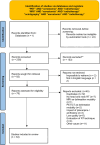Assessment and Prediction of Salivary Gland Function After Head and Neck Radiotherapy: A Systematic Review
- PMID: 39679450
- PMCID: PMC11647549
- DOI: 10.1002/cam4.70494
Assessment and Prediction of Salivary Gland Function After Head and Neck Radiotherapy: A Systematic Review
Abstract
Background: Modern imaging techniques with magnetic resonance imaging (MRI) or positron emission tomography/computed tomography (PET/CT) have recently been developed to assess radiation-induced damage to salivary structures. The primary aim of this review was to summarize evidence on the imaging modalities used for the assessment and prediction of xerostomia after head and neck radiotherapy (RT).
Methods: A systematic review of the literature was performed using successively the MeSH terms "PET," "MRI," "scintigraphy," "xerostomia," and "radiotherapy."
Results: Salivary excretion flow following head and neck RT is correlated with the dose delivered to both parotid and submandibular glands. Salivary gland standardized uptake value extracted from PET/CT following RT has been shown to be correlated with SEF. Models including early SUV decline or ADC increase during RT and clinical parameters can help predict the loss of salivary function after RT.
Conclusions: Modern imaging parameters appear to be correlated with salivary gland scintigraphy parameters. Models including functional parameters extracted from either PET/CT or MRI unveil new possibilities for adaptive treatment in a selected population of patients.
Keywords: MRI; PET/CT; head and neck cancer; radiotherapy; salivary gland; xerostomia.
© 2024 The Author(s). Cancer Medicine published by John Wiley & Sons Ltd.
Conflict of interest statement
The authors declare no conflicts of interest.
Figures


References
-
- Beetz I., Schilstra C., van der Schaaf A., et al., “NTCP Models for Patient‐Rated Xerostomia and Sticky Saliva After Treatment With Intensity Modulated Radiotherapy for Head and Neck Cancer: The Role of Dosimetric and Clinical Factors,” Radiotherapy and Oncology 105 (2012): 101–106, 10.1016/j.radonc.2012.03.004. - DOI - PubMed
Publication types
MeSH terms
LinkOut - more resources
Full Text Sources
Medical

